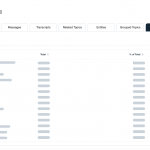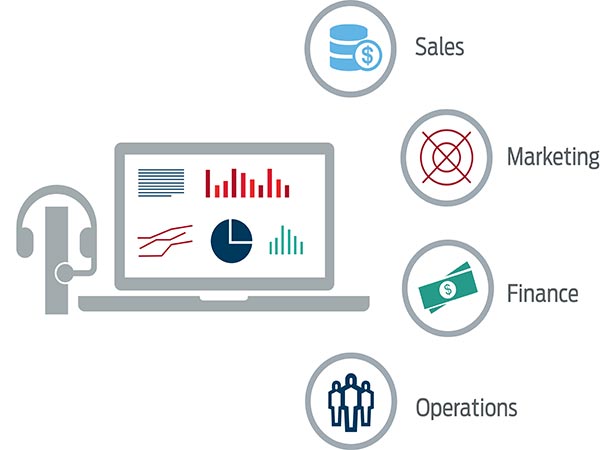9 Ways Call Center Data Can Improve Customer Engagement
9 Ways Call Center Data Can Improve Customer Engagement

There’s no way around it: technology will continue to enhance the business landscape and companies will need to innovate in order the stay ahead of the competition. As artificial intelligence (AI) and other technologies become more common, customers are conscious of the shift, making it more important than ever for contact centers to quickly adapt to meet the needs of modern customers.
While many members of the C-suite continue to put the customer experience as a top priority, the challenge of creating a customer-first model lies in the lack of tools–or access to the right tools–and siloed data. Even as contact centers use more technologies to manage customer interactions, many find it challenging to extract the voice of customer (VoC) insights hidden in their own data.
WHY ARE COMPANIES STRUGGLING TO LEVERAGE CALL CENTER DATA TO IMPROVE CUSTOMER ENGAGEMENT?
In our report, Business Transformation and Analytics: Driving Change in a Customer-Centric World, we found that 85 percent of executives agreed that data and analytics are important to informing sales and marketing changes. However, 68 percent also admitted to avoiding a major change initiative in their business because of an “if it ain’t broke, don’t fix it” attitude.
This same report also revealed that when it comes to data sources, 39 percent of executives admitted to relying on a limited set of numbers that are the easiest to derive, such as:
- revenue figures;
- social media data;
- sales figures; and
- feedback from the team.
While these data points are important, they lack the deep insights that can be found in the real customer conversations that happen in the contact center. This can put companies at risk of losing customers to a competitor providing a more engaging experience.
Yet, in most contact centers, only around 2 percent of conversations ever get a second look, and the other 98 percent of insights remain buried. This first-hand intelligence is being wasted when in fact it could be used to drive organizational change, increase profits and improve the customer experience.
How Companies Can Take Advantage of the Customer Data Collected in the Contact Center
So how can analytics help? Data-driven organizations who utilize the insights extracted from their contact center data will have access to the unfiltered VoC, so you’ll know exactly what customers want–and more importantly, what they don’t–and how they want it delivered.
Yet, there are so many ways to use analytics that contact center leaders often are stumped with where to start when they want to deploy it for the first time—or what to do once their first analytics project is up and running.
Calabrio CMO Rebecca Martin, recently shared with customer service expert, Shep Hyken, that “to stay ahead, companies need to figure out how to turn data into action.”
At Calabrio, we consistently see how call center analytics deliver extremely high value when it comes to customer engagement in the contact center–no matter each organization’s unique goals and pain points.
Here are nine ways, grouped by three common organizational objectives, that companies can use analytics and customer data to improve their relationships with customers.
OBJECTIVE: IDENTIFY PLACES TO IMPROVE CUSTOMER SATISFACTION
The happier customers are, the more likely they are to remain loyal to an organization–which is why many organizations rank customer retention as a top priority.
The first area we see companies using analytics—including analytics that leverages artificial intelligence (AI)-driven machine learning—is to discover ways to makes a customer’s journey smoother by alleviating contact center pain points and anticipating a customer’s future needs.
Call center analytics easily alleviates these pain points, and in turn, increases customer engagement by:
- Helping contact center managers increase first call resolution (FCR)
FCR is consistently prioritized as the contact center’s number one metric for good reason: studies have shown that customer satisfaction drops by 15% each time a customer has to call back to have their issue resolved. Analytics allow managers to not only track their repeat call volume but also – critically – gets them to the root causes so they can quickly improve their FCR and keep their customers happy. - Ensuring contact center evaluators perform truly targeted quality management
Machine learning can be used generate predictive evaluation scores for 100% of interactions, which makes it possible for evaluators to focus their time on the right calls and use those quality insights to provide impactful coaching to the agents who need it most. - Identifying agents who consistently get high evaluations from customers
Machine learning can also be used to identify agents who consistently deliver quality customer experiences. This helps managers and trainers discover tactics that they can use to train other agents, as well as making it possible to recognize top agents for their performance. - Helping contact center managers improve proactive outreach
By using machine learning to generate predictive Net Promoter Scores (NPS) for every customer interaction – regardless of whether the customer completed a survey – managers can see 100% of their promoters, detractors, and passives and target them with the appropriate efforts. - Allowing the organization as a whole quickly detect customers at risk of attrition–and respond
When a customer is frustrated, they frequently use words that can be classified by an analytics solution as having a negative sentiment. Call center data can be used to identify those customers and take actions to retain them, driving up the overall lifetime value (LTV) for customers.
OBJECTIVE: QUICKLY RESPOND TO ISSUES NEGATIVELY IMPACTING CUSTOMER ENGAGEMENT.
Understanding how a customer feels about your organization can be a challenge, but it’s a powerful way to gain critical insights about your contact center, your product and your company. That’s because sentiment analysis, a new technology that’s part of call center analytics, can help you understand not only what callers say but how they feel.
Sentiment analysis works by analyzing each element of a customer conversation to assign a sentiment score of positive, negative or neutral. It runs concurrently with a call center workforce optimization solution to correlate sentiment data with metrics such as call duration, hold time, silence, NPS and even evaluator scores. By spotting trends in sentiment in near-real time, organizations can quickly make changes that impact the customer engagement.
Here’s how call center analytics can be used to identify customer sentiment–and enable your organization to quickly respond.
- Find and address call center interactions leading to negative customer experience
Contact center managers can segment calls with negative sentiment scores by agent, team or group and then proactively monitor negatively scored interactions within a specific team or group. They can use this sentiment segmentation to identify optimal opportunities for agent coaching; decide how to handle emerging issues; and predict the sentiment of future calls. - Identify opportunities to improve customer engagement outside the call center
The entire organization can use sentiment analysis to recognize and rectify potential issues well ahead of indications they might receive from lagging KPIs such as NPS or sales surveys. They can spot in-flight sentiment trends, then nimbly adjust affected business functions to replicate positive sentiment or triage negative sentiment. And they can easily discern between customers that will actually churn versus those simply bluffing.
OBJECTIVE: AGGREGATE CUSTOMER AND AGENT EMPLOYEE DATA AND INSIGHTS ACROSS MULTIPLE TECHNOLOGY PLATFORMS
With customers interacting with organizations across more channels than ever before, it’s becoming harder and harder to keep track of all the factors that impact customer experience. Data Management can be used to break down those data silos by combining call center data with automatic call distribution (ACD), interactive voice recognition (IVR), quality monitoring, workforce management, CRM, human resources, homegrown software applications, and even social media data.
By seamlessly compiling both voice of the customer (VoC) and voice-of-the-employee (VoE) information from multiple systems and visually displaying the integrated data, analytics lets contact centers comprehensively understand and continually improve their customer experiences without having to constantly increase budget or headcount to do it.
Here’s how analytics can help improve customer engagement by compiling data from multiple channels:
- Enable contact center managers to conduct cross-channel quality monitoring
By aggregating and analyzing data from multiple channels using sophisticated, visual tools; managers can evaluate agents from many different internal and external perspectives; improve agent training in near real time; combine quality scores from evaluators with feedback from customers and the agent herself; and highlight the best interactions and the top-performing agents. - Allows the organization to gain a more comprehensive understanding of agent performance
Managers can easily deliver different communications to detractors versus promoters (or neutral customers) in order to maximize a message’s impact; create mathematical approximations of both customer and agent behavior to predict the outcomes that will deliver the greatest results; and have more time to innovate on the overall customer experience.
The race to innovate is well underway, and it’s clear that in order to increase customer engagement in the call center, organizations will need to find ways to better utilize the data that’s right at their fingertips–and they’ll need to leverage analytics to do so.
At its core, analytics automates tasks that otherwise would dominate an agent’s, manager’s or organization’s time, while delivering meaningful insights that can be used to continually improve the customer experience – and might otherwise go entirely undiscovered.
In an era when recognizing the signs of customer dissatisfaction after a customer is lost just won’t do. Companies need to determine when and where customers start to become disengaged with your company. And that means analytics is a “when”—not an “if”—investment. And the “when” is now.
Find out how Radial uses analytics to deliver more actionable insights to its internal agents and clients—read the case study.









